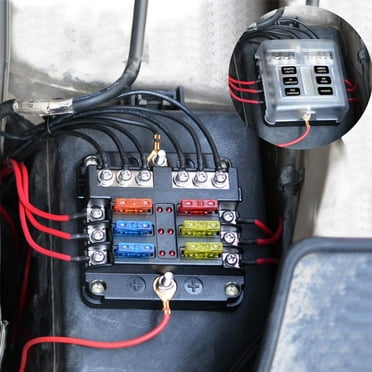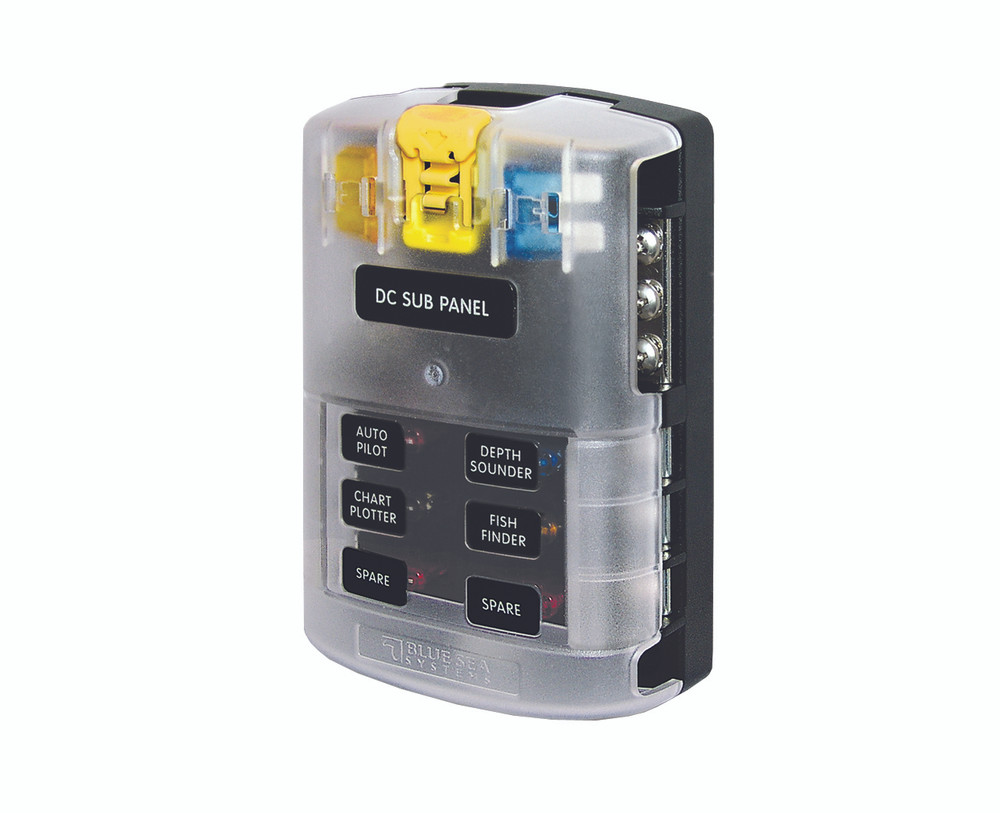The Basic Principles Of Blue Sea Fuse Block
Wiki Article
Blue Sea Fuse Block Fundamentals Explained
Table of ContentsSome Known Factual Statements About Blue Sea Fuse Block The 3-Minute Rule for Blue Sea Fuse Block7 Simple Techniques For Blue Sea Fuse BlockBlue Sea Fuse Block - QuestionsSome Known Details About Blue Sea Fuse Block The Best Strategy To Use For Blue Sea Fuse Block
Fuses are bolted in position between the bus bar and the 2nd set of electrically separated bolts. With this installment you can attach the watercraft's numerous high-current circuits, such as a windlass, bow thruster, high-output alternator, the DC panel, etc, to the isolated bolts. The different merges are sized according to the current-carrying ability of the conductors bolted to them.Some circuits will still need to bypass the isolation switch to ensure that they may be left on when the rest of the boat is closed down. blue sea fuse block. These circuits commonly consist of a bilge pump as well as any type of billing gadgets (including photovoltaic panels, possibly a wind generator, as well as the inverter if it likewise doubles as a battery charger).
This becomes part of the circuit representation we established for the complicated instance watercraft in our Boat Electrics training course. The devices linked to the fuse block in the top right are all bypassing the seclusion switch S1. If you enroll in Boat Electrics 101, you will certainly discover just how to review such a representation and additionally how to make one for your own watercraft.
Not known Details About Blue Sea Fuse Block

The goal is to offer security at the resource of power for each and every circuit. With DC circuits, the OCP is always placed in the silver lining of DC circuits. (Apart from anything else, an unbroken connection to DC adverse should be kept in all times to shield against stray-current deterioration.) Keep in mind that some European boatbuilders mount merges and battery switches in the DC adverse side and on the silver lining, yet this is not recommended except in some separated (drifting) ground DC systems.
This point may go to the battery, the battery button, the distribution panel, a subsidiary panel, some distribution bus bar, or various other linking point. If the conductors in the new circuit are no smaller sized than the conductor that feeds the new circuit's point of link, then the OCP for the feeder conductor will adequately shield the new circuit - blue sea fuse block.
Not known Factual Statements About Blue Sea Fuse Block
Yet if the brand-new circuit is not sufficiently served by overcurrent devices already in area, additional protection is required at its point of link, i. e., at its resource of power. Positioning of fuses in the favorable conductor. Keep in mind just how a smaller fuse is utilized each time a smaller sized conductor is attached, Often area restricts exactly how close an OCP gadget can be put to the resource of power.The common solution, from the ABYC, is within 7" (17. The ABYC permits the following, which have been tightened up in recent years: A conductor linked straight to a battery that is additionally "consisted of throughout its entire range in a sheath or unit such as an avenue, joint box, control box or enclosed panel" must have its overcurrent protection "as close as practicable to the battery, but not to exceed 72 inches (1.
Gone is the covering 72" allocation that utilized to be there. A conductor linked to a source of power apart from the battery (e. g., the battery button, the distribution panel, or a few other factor in the DC look at this now circuits) that is similarly contained in a sheath, etc, need to have its overcurrent protection "as close as possible to the point of connection to the resource of power, yet not to go beyond 40 inches (1.
you can check here
3 Simple Techniques For Blue Sea Fuse Block
e., anywhere it ties into the DC system. Provided that alternators themselves give power, it has been open to question whether these included generators required OCP at the alternator itself. This has been resolved in the current variation of the ABYC E-11 requirement as complies with: "Overcurrent protection is not needed at an alternator if the ampacity of the conductor amounts to or higher than the rated outcome of the generator."Cranking-motor circuits are not called for to have overcurrent protection.In the aquatic field, where cranking circuits may be long, this technique may develop a risk. It makes no sense to have any kind of unprotected circuits on a boat.
In cold weather, the inrush existing on a 12V starter motor might be as high as 1,500 amps; the cranking current may be as long as 200 amps. Typically, cranking conductors are undersized also for the cranking existing, let alone the inrush present. This situation webpage does not position a safety problem per se, because these currents are endured for just a few seconds, so the conductors do not have time to fume adequate to create a fire hazard.
Blue Sea Fuse Block - Questions
If you want to discover how to wire a boat, detailed in 56 video lessons, have a look at our Watercraft Electrics 101 course. We made the training course with absolute newbies in mind. As the electrical lots on boats boosts, so too does the intricacy of electrical circuits and also the possibility for brief circuits and also electric fires.
In the aquatic area, where cranking circuits might be long, this method could produce a hazard. If a car ignites, the residents can draw over as well as leap out. If a boat ignites, it is not so simple. It makes no sense to have any unsafe circuits on a watercraft.
Blue Sea Fuse Block Fundamentals Explained

If you wish to learn exactly how to wire a watercraft, step-by-step in 56 video lessons, inspect out our Boat Electrics 101 training course. We made the course with outright novices in mind. As the electric load on boats boosts, so as well does the intricacy of electric circuits and the capacity for brief circuits as well as electrical fires.
Report this wiki page